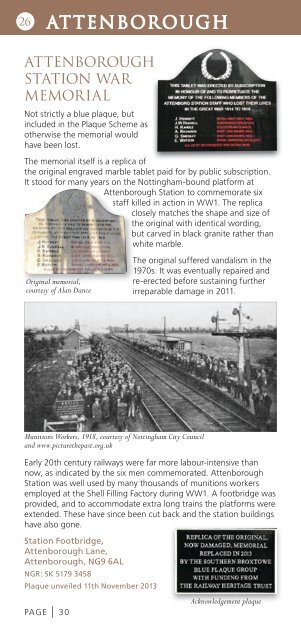GUIDE TO THE BLUE PLAQUES
BP%20final%20proof.2016.05.03
BP%20final%20proof.2016.05.03
Create successful ePaper yourself
Turn your PDF publications into a flip-book with our unique Google optimized e-Paper software.
ATTENBOROUGH<br />
ATTENBOROUGH<br />
26 27<br />
ATTENBOROUGH<br />
STATION WAR<br />
MEMORIAL<br />
Not strictly a blue plaque, but<br />
included in the Plaque Scheme as<br />
otherwise the memorial would<br />
have been lost.<br />
The memorial itself is a replica of<br />
the original engraved marble tablet paid for by public subscription.<br />
It stood for many years on the Nottingham-bound platform at<br />
Attenborough Station to commemorate six<br />
staff killed in action in WW1. The replica<br />
closely matches the shape and size of<br />
the original with identical wording,<br />
but carved in black granite rather than<br />
white marble.<br />
Original memorial,<br />
courtesy of Alan Dance<br />
The original suffered vandalism in the<br />
1970s. It was eventually repaired and<br />
re-erected before sustaining further<br />
irreparable damage in 2011.<br />
GENERAL HENRY IRE<strong>TO</strong>N<br />
1611-1651<br />
A principal player in the English Civil War,<br />
Henry lreton was born at Ireton House,<br />
Attenborough, a Grade II listed former<br />
farmhouse, in the Attenborough Village<br />
Conservation Area.<br />
The son of puritan parents who were<br />
prosecuted for their beliefs, he trained<br />
as a lawyer and, when King Charles I raised<br />
his standard at Nottingham in 1642 to gather an<br />
army to attack Westminster, Henry Ireton sided with Parliament. He<br />
married Oliver Cromwell’s daughter Bridget in 1646, and became<br />
his right-hand man, engaging in many battles, including<br />
Marston Moor and Naseby. After Charles’s defeat and<br />
trial for treason, Ireton was a signatory to the King’s death<br />
warrant, with the execution following in January 1649.<br />
Munitions Workers, 1918, courtesy of Nottingham City Council<br />
and www.picturethepast.org.uk<br />
Early 20th century railways were far more labour-intensive than<br />
now, as indicated by the six men commemorated. Attenborough<br />
Station was well used by many thousands of munitions workers<br />
employed at the Shell Filling Factory during WW1. A footbridge was<br />
provided, and to accommodate extra long trains the platforms were<br />
extended. These have since been cut back and the station buildings<br />
have also gone.<br />
Station Footbridge,<br />
Attenborough Lane,<br />
Attenborough, NG9 6AL<br />
NGR: SK 5179 3458<br />
Plaque unveiled 11th November 2013<br />
PAGE | 30<br />
Acknowledgement plaque<br />
Ireton House and Attenborough Church, 1910<br />
Ireton joined Cromwell’s Ireland campaign in 1649 and was left<br />
in command when Cromwell returned to England in 1650. The<br />
following year Ireton besieged Limerick, then captured it, but<br />
shortly afterwards he died there of the plague. He was given a state<br />
funeral at Westminster Abbey, but did<br />
not rest there for long. After the 1660<br />
restoration of the monarchy, Charles II’s<br />
government had Ireton’s body exhumed<br />
and hung in chains.<br />
Ireton House was also the birthplace of<br />
Henry’s younger brother John (1615-<br />
1689). He became a London merchant<br />
and was knighted by Cromwell; in 1658<br />
he was Lord Mayor of London.<br />
15 Church Lane,<br />
Attenborough, NG9 6AS<br />
NGR: SK 5180 3430<br />
Plaque fixed 22nd June 2011<br />
Henry Ireton<br />
PAGE | 31


